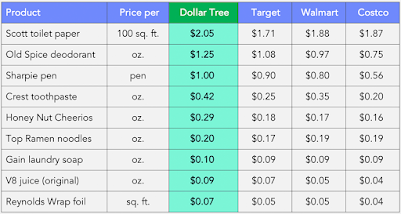 |
| Unit prices at Dollar Tree, larger retailers (Chart by The Hustle; click on it to enlarge) |
But, as a recent article from The Hustle shows, dollar stores may not save shoppers much money. Dollar stores often work with brands to create smaller products that fit the $1 price point. Usually, those smaller products are more expensive per unit than the full-sized versions at other retailers.
"Dollar stores count on customers either not being able to afford buying larger sizes elsewhere, or simply not doing the math," Zachary Crocket reports. "The core demographic of dollar stores — lower-income families who earn less than $40,000 per year — are often living paycheck to paycheck and can't afford to buy in larger quantities, even if it means getting a better deal."
Stagnant wages and a shrinking middle class may enlarge dollar stores' core demographic, but rising inflation means they might have to make their products even smaller and further cut back on quality to keep prices at $1, Crockett reports.
No comments:
Post a Comment